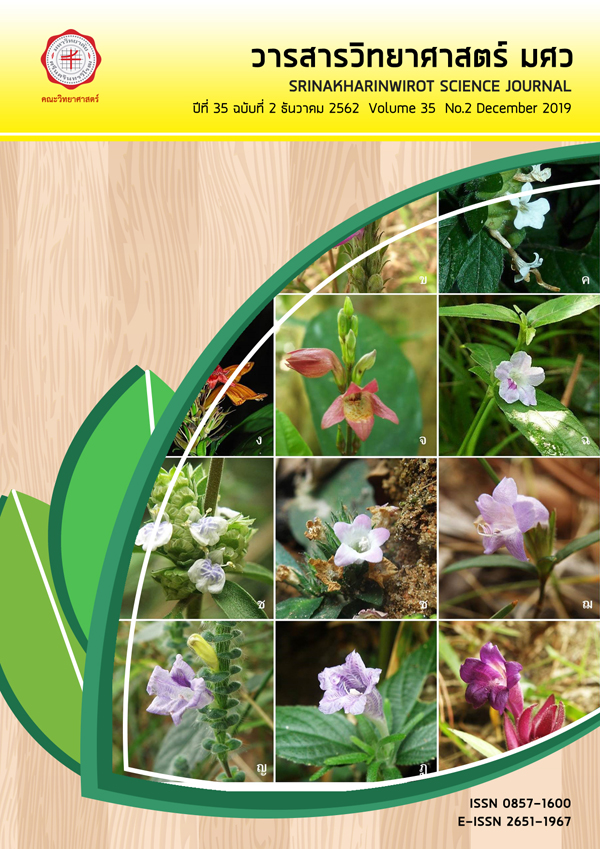In Vitro Propagation of Curcuma candida (Wall.) Techapr. & Škornick., a Vulnerable Plant of Thailand
Keywords:
Curcuma candida, Vulnerable plant, In vitro propagation, Sucrose, Plant growth regulatorsAbstract
บทคัดย่อ ต้นดอกดิน (Curcuma candida (Wall.) Techapr. & Škornick. จัดเป็นพืชกึ่งถิ่นเดียวในวงศ์ขิงที่ถูกคุกคามและมีความเสี่ยงต่อการสูญพันธุ์ ควรตระหนักถึงการอนุรักษ์สายพันธุ์พืชชนิดนี้ไว้เป็นสำคัญ การศึกษานี้มุ่งหาวิธีการขยายพันธุ์พืชในหลอดทดลอง โดยนำตาข้างที่ได้จากส่วนโคนของลำต้นเหนือดินของต้นดอกดินที่เจริญตามธรรมชาติที่ผ่านการฟอกฆ่าเชื้อผิวมาเลี้ยงบนอาหารวุ้นสูตร Murashige และ Skoog (MS) ทำให้ได้ต้นอ่อนปลอดเชื้อเพื่อนำไปใช้เป็นชิ้นส่วนเริ่มต้นในขั้นตอนต่อไป เพื่อที่จะศึกษาปริมาณน้ำตาลที่เหมาะสมต่อการเจริญของต้นดอกดิน จึงนำยอดที่เกิดขึ้นใหม่ที่มีความสูง 6 - 7 เซนติเมตร มาตัดให้เหลือส่วนโคนลำต้นขนาด 1.5 เซนติเมตร ก่อนนำไปเลี้ยงบนอาหารวุ้นสูตร MS ที่มีน้ำตาลซูโครส 0 - 40 กรัม/ลิตร นาน 8 สัปดาห์ พบว่า ชิ้นพืชที่เลี้ยงบนอาหารวุ้นที่มีน้ำตาลซูโครสเข้มข้น 30 กรัม/ลิตร มีร้อยละของการเกิดยอดใหม่ 100 และมีจำนวนยอดใหม่ที่เกิดขึ้นต่อชิ้นพืชมากที่สุด จากการนำต้นที่เกิดขึ้นจากอาหารสูตรที่เติมน้ำตาลซูโครส 30 กรัม/ลิตร มาตัดให้เหลือส่วนโคนก่อนนำไปเลี้ยงบนอาหารวุ้นสูตร MS ที่มีเบนซิลอะดีนีน (benzyladenine: BA) เข้มข้น 0-4 มิลลิกรัม/ลิตร เพียงชนิดเดียว หรือมีไคนิทีน (kinetin: KN) เข้มข้น 0.5 มิลลิกรัม/ลิตร ร่วมอยู่ด้วย นาน 8 สัปดาห์ จากนั้นย้ายเนื้อเยื่อไปเลี้ยงบนอาหารวุ้นสูตร MS ที่ไม่เติมสารควบคุมการเจริญเติบโตของพืช ต่อไปอีก 4 สัปดาห์ พบว่าอาหารวุ้นสูตร MS ที่มี BA เข้มข้น 2 มิลลิกรัม/ลิตร เป็นสูตรอาหารที่สามารถชักนำให้เกิดจำนวนยอดใหม่สูงที่สุด (10.40+0.68 ยอด/ชิ้นพืช) อีกทั้งไม่ส่งผลต่อการยืดยาวของยอดใหม่และการเจริญของราก นอกจากนี้ต้นพืชที่เกิดขึ้นจากอาหารสูตรดังกล่าวยังมีร้อยละการรอดชีวิตที่สูงที่สุด (95) หลังจากนำไปอนุบาลและออกปลูกนาน 6 สัปดาห์ ดังนั้นผลที่ได้จากการศึกษานี้จึงเป็นประโยชน์ต่อการขยายพันธุ์และอนุรักษ์ต้นดอกดิน และสามารถประยุกต์ใช้ให้เกิดประโยชน์ในเชิงเศรษฐกิจโดยไม่รบกวนพืชที่มีอยู่ในธรรมชาติอันเป็นการรักษาพันธุ์พืชอย่างยั่งยืน คำสำคัญ: ดอกดิน พืชถูกคุกคาม การขยายพันธุ์ในหลอดทดลอง น้ำตาลซูโครส สารควบคุมการเจริญเติบโตของพืชABSTRACT Curcuma candida (Wall.) Techapr. & Škornick. (Zingiberaceae), a semi-endemic plant, is classified as a vulnerable plant and estimated to be at risk of extinction. Therefore, conservation of this plant needs to be concerned. This study aimed to investigate in vitro propagation protocol of C. candida. Leafy-shoot base of natural grown C. candida were surface sterilized and axillary buds were separated and cultured on Murashige and Skoog (MS) agar medium. To investigate an appropriated sucrose concentration for culturing C. candida, in vitro shoots at the height of 6-7 cm were selected and their leafy-shoot bases were excised to 1.5 cm in height, and then inoculated onto Murashige and Skoog (MS) agar medium supplemented with 0-40 g/L sucrose. The result found that 100% of shoot induction and maximum number of shoots per explant could observe on the medium added with 30 g/L sucrose at 8 weeks of culture. Leafy-shoot bases received from the medium containing 30 g/L sucrose were excised and cultured on MS agar medium supplemented with 0-4 mg/L benzyladenine (BA) alone or in combination with 0.5 mg/L kinetin (KN). After 8 weeks of culture, all regenerants were transferred to plant growth regulators (PGRs)-free medium for another 4 weeks. The results revealed that MS agar medium supplemented with 2 mg/L BA was suitable for mass multiplication of C. candida. This medium provided the highest number of new shoots (10.40 ± 0.68 shoots/explant) and did not affect to new shoot height and root regeneration. The highest survival percentage (95%) after 6 weeks of acclimatization was also obtained from the plantlets which grown in this medium. As a consequence, this protocol will be useful for commercialized rapid propagation and germplasm conservation via in vitro preservation of C. candida without natural population disturbance.Keywords: Curcuma candida, Vulnerable plant, In vitro propagation, Sucrose, Plant growth regulatorsDownloads
Download data is not yet available.
Downloads
Published
2019-08-30
How to Cite
Chuengpanya, R., Chuenboonngarm, N., Kongtook, N., Longsaward, R., Nopporncharoenkul, N., Muangkroot, A., Jenjittikul, T., & Soonthornchainaksaeng, P. (2019). In Vitro Propagation of Curcuma candida (Wall.) Techapr. & Škornick., a Vulnerable Plant of Thailand. Science Essence Journal, 35(2), 31–50. Retrieved from https://ejournals.swu.ac.th/index.php/sej/article/view/11089
Issue
Section
Research Article








